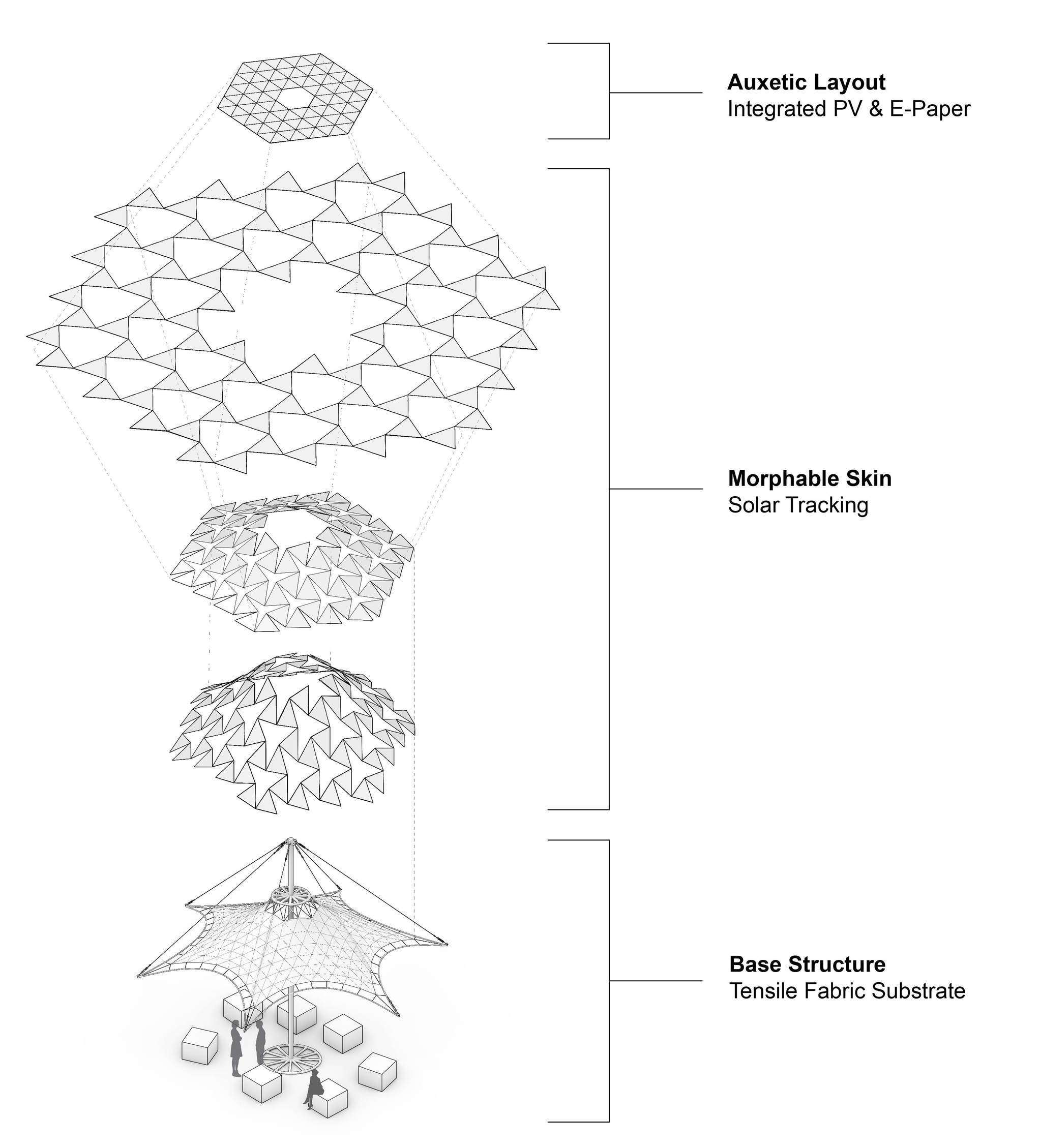From pv magazine USA
Researchers from Cornell University are working to create a portable, dual-axis canopy of approximately 14 m2 that will morph and track the sun to optimize solar energy capture.
For HelioSkin, part of their brand’s vision is to “make solar attractive so people actually find it usable and interesting.”
The “morphing skin” would track sunlight and have the flexibility and surface area to wrap across large surfaces, such as buildings and stadiums.

The researchers said they are working to address two problems:
- Single-axis sun tracking with planar silicon systems can generate as much as 10% to 40% more energy depending on the geographic location, but there is more site preparation and more maintenance required than conventional systems.
- Poor design quality and aesthetics hinder the large-scale public adoption of solar panels in the residential sector.
HelioSkin began in a partnership between Jenny Sabin, an architectural designer at Cornell University, and Mariana Bertoni, an energy engineer at Arizona State University who specializes in photovoltaics. They began combining computational design, digital fabrication and 3D printing to create photovoltaic panel assemblies that would not only boost light absorption but also catch the eye.
The key, they found, was to look at the mechanics of heliotropism, so they brought in Adrienne Roeder, a professor in plant biology at Cornell University. Heliotropism is an ability found in many plants, such as sunflowers, to move in the direction of the sun.
Today, the research team spans across a variety of sciences, including plant biologists, engineers, physicists, mathematicians and architects. The research is funded through a $650,000 grant from the National Science Foundation Project. The grant covers the project’s first phase, and the team has applied for funding for the next phase – a three-year pilot – for $5 million.
“Beauty and sustainable design are an essential part of nature,” the researchers said of their hypothesis, “and it has been demonstrated that solar tracking produces a photosynthetic advantage in the plant suggesting that it will be similarly beneficial for photovoltaic systems.”
“We’ve discovered that the best way to track the sun is at the global scale of the surface,” Sabin said. “Rather than energy-hungry components that are mechanically tracking and potentially breaking down, we will have tracking at the whole surface and also working at a very slow pace.”
Co-Principal Investigator Itai Cohen, a physics professor at Cornell University, said that in many cases, people shy away from solar panels because of the cost and the aesthetics. “Many solar panels are just ugly,” he said.
Roeder said their goal is for HelioSkin to morph and track light from scale “all the way to building scale,” she said. “If you slap these ugly solar cells on your house, people don’t want that.”
(See also: Beauty in design: Five solar PV projects that caught our eye in 2021)
While their ultimate goal is to wrap buildings in their flexible solar “morphing skin,” In the pilot project the researchers plan to create a portable, dual-axis canopy of approximately 150 square feet that will morph and track the sun to optimize solar energy capture. The tensile system will host low-power, tunable electronic paper displays manufactured from roll-to-roll printing to enable consumer branding and lighting customization capabilities.

HelioSkin is collaborating with E Ink, an electronic paper display company, which enables them to produce photovoltaic sheets in large quantities and at a relatively low cost, similar to perovskite cells.
To do this, HelioSkin uses roll-to-roll printing of photovoltaic and E Ink materials integrated onto the same sheet. Those sheets could then be wrapped around any object to give “second skins” to structures, Cohen said, “and because E ink has the capacity to fabricate kilometers of this stuff every day,” he added, “you could imagine really wrapping very large objects up to things like maybe a skyscraper.”

(See also: Active Surfaces raises $5.6 million to develop ‘solar 2.0’)
The project’s second phase is to refine the HelioSkin prototype’s sensing, wiring, arrangement of panels, geometry and substrate. For this stage, HelioSkin is working with SunFlex, a company that uses laser-welded back contact module technology for photovoltaic manufacturing.
HelioSkin has not disclosed figures related to its cost or system capacity. However, Cornell University said the Helioskin team conducted extensive marketing analysis and interviews that showed HelioSkin’s gross cost, cost per W and system capacity were competitive with existing PV products.
Sabin said the building industry contributes to 40% of the world’s CO2 emissions. “That is a huge, huge problem,” she said. “If we can just start to shift that margin, turn the needle by bringing together performance, function, bio-inspired design strategies, and importantly, good design and aesthetics, we have something that will be truly transformative and impactful.”
“Imagine a skyscraper wrapped with these incredible geometries and forms that open up new questions around these important issues,” she said. “Making sustainability interesting, making it sexy to invite people to get involved, to get excited and fundamentally bringing people together,” she said, adding, “bringing solar to life.”
This content is protected by copyright and may not be reused. If you want to cooperate with us and would like to reuse some of our content, please contact: editors@pv-magazine.com.




By submitting this form you agree to pv magazine using your data for the purposes of publishing your comment.
Your personal data will only be disclosed or otherwise transmitted to third parties for the purposes of spam filtering or if this is necessary for technical maintenance of the website. Any other transfer to third parties will not take place unless this is justified on the basis of applicable data protection regulations or if pv magazine is legally obliged to do so.
You may revoke this consent at any time with effect for the future, in which case your personal data will be deleted immediately. Otherwise, your data will be deleted if pv magazine has processed your request or the purpose of data storage is fulfilled.
Further information on data privacy can be found in our Data Protection Policy.